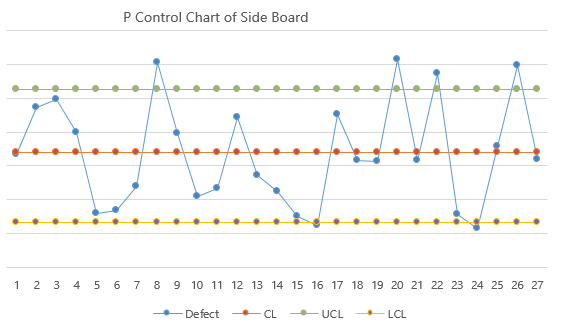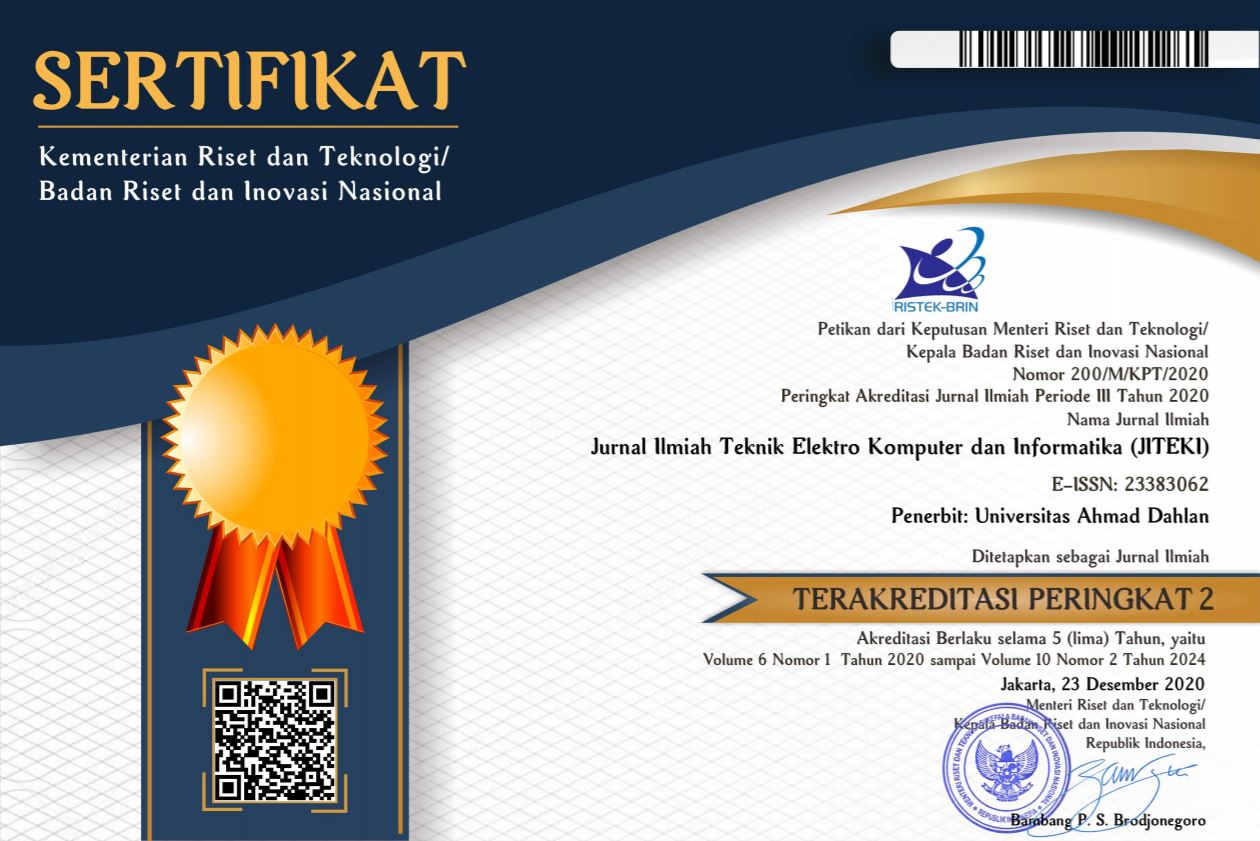
Evaluation of Product Quality Improvement Against Waste in the Electronic Musical Instrument Industry
Abstract
Keywords
Full Text:
PDFReferences
E. Haviana and Hernadewita, “Productivity improvement in the rubber production process using value stream mapping method to eliminate waste,†Operations Excellence, vol. 11, no. 2, pp. 119–130, 2019. https://doi.org/10.22441/oe.v11.2.2019.023
G. Santos, J. Carlos, S. Ricardo, J. Pulido, G. Jimenez, and H. Hernández, “Improvement of Productivity and Quality in the Value Chain through Lean Manufacturing – a case study,†Procedia Manufacturing, vol. 41, pp. 882–889, 2019. https://doi.org/10.1016/j.promfg.2019.10.011
N. M. Ahmed, M. A. Sharief, and A. B. A. Nasr, “Implement Lean Thinking in Automotive Service Centers to Improve Customers’ Satisfaction,†International Journal of Scientific & Engineering Research, vol. 6, no. 6, 576–583, 2015. https://www.ijser.org/researchpaper/Implement-Lean-Thinking-in-Automotive-Service-Centers-to-Improve-Customers-Satisfaction.pdf
M. T. Pereiraa, Bentoa, Ferreiraa, J. C. Sá, F. J. G. Silvaa, and A. Baptista, “Using Six Sigma to analyse Customer Satisfaction at the product design and development stage,†29th International Conference on Flexible Automation and Intelligent Manufacturing, vol. 38, 2019, pp. 1608–1614, 2019. https://doi.org/10.1016/j.promfg.2020.01.124
I. Setiawan and Setiawan, “Defect reduction of roof panel part in the export delivery process using the DMAIC method: a case study,†Jurnal Sistem dan Manajemen Industri, vol. 4, no. 2, pp. 108–116, 2020. https://doi.org/10.30656/jsmi.v4i2.2775
M. M. Saxena and KVN S. Rao, “Quality management, total quality management and six sigma,†International Journal of Scientific and Technology Research, vol. 8, no. 12, pp. 394–399, 2019. http://www.ijstr.org/final-print/dec2019/Quality-Management-Total-Quality-Management-And-Six-Sigma.pdf
B. I. Saleh and S. Hasibuan, “Analysis for Enhancing Quality and Productivity Using Overall Equipment Effectiveness and Statistical Process Control in Manufacturing Industry Case Study: Manufacturing Industry Sport Shoes in Tangerang Region,†International Journal of Innovative Science and Research Technology, vol. 4, no. 12, pp. 108–114, 2019. https://www.ijisrt.com/assets/upload/files/IJISRT19DEC308.pdf
I. Siregar, A. A. Nasution, U. Andayani, R. M. Sari, K. Syahputri, and Anizar, “Lean manufacturing analysis to reduce waste on production process of fan products,†IOP Conference Series: Materials Science and Engineering, vol. 308, 2018. https://doi.org/10.1088/1757-899X/308/1/012004
H. Henny, I. Andriana, A. N. Latifah, and H. Haryanto, “The Application Lean Six Sigma Method Approach to Minimize Waste,†IOP Conference Series: Materials Science and Engineering, vol. 662, no. 2, 2019. https://doi.org/10.1088/1757-899X/662/2/022089
A. Karim and K. Arif-uz-zaman, “A methodology for effective implementation of lean strategies and its performance evaluation in manufacturing organizations,†Business Process Management Journal, vol. 19, no. 1, pp. 169–196, 2014. https://doi.org/10.1108/14637151311294912
Khairunnisa, J. Hidayati, and A. Shalihin, “Reducing waste order production process more efficient approach effective and lean manufacturing (Journal Review),†IOP Conference Series: Materials Science and Engineering, vol. 725, no. 1, 2020. https://doi.org/10.1088/1757-899X/725/1/012001
V. Ramakrishnan, and J. Jayaprakash, “Application of Lean Six Sigma Tools for Reduction of Defects in Pump Manufacturing,†Applied Mechanics and Materials, vol. 813–814, pp. 1140–1149, 2015. https://doi.org/10.4028/www.scientific.net/AMM.813-814.1140
R. D. Adikorley, L. Rothenberg, and A. Guillory, “Lean Six Sigma applications in the textile industry: a case study,†International Journal of Lean Six Sigma, vol. 8, no. 2, pp. 210–224, 2017. https://doi.org/10.1108/IJLSS-03-2016-0014
T. A. Tran, K. Luu-Nhan, R. Ghabour, and M. Daroczi, “The use of Lean Six-Sigma tools in the improvement of a manufacturing company – Case study,†Production Engineering Archives, vo. 26, no. 1, pp. 30–35, 2020. https://doi.org/10.30657/pea.2020.26.07
A. Ishak, K. Siregar, R. Ginting, and D. Gustia, “Reducing waste to improve product quality in the wooden pallet production process by using lean six sigma approach in PT. XYZ,†IOP Conference Series: Materials Science and Engineering, vol. 1003, no. 1, pp. 1–10, 2020. https://doi.org/10.1088/1757-899X/1003/1/012090
A. Pugna, R. Negrea, and S. Miclea, “Using Six Sigma Methodology to Improve the Assembly Process in an Automotive Company,†13th International Symposium in Management, vol. 221, pp. 308–316, 2016. https://doi.org/10.1016/j.sbspro.2016.05.120
S. J. Raval, R. Kant, and R. Shankar, “Benchmarking the Lean Six Sigma performance measures: a balanced score card approach,†Benchmarking, vol. 26, no. 6, pp. 1921–1947, 2019. https://doi.org/10.1108/BIJ-06-2018-0160
N. Nandakumar, P. G. Saleeshya, and P. Harikumar, “Bottleneck Identification and Process Improvement by Lean Six Sigma DMAIC Methodology,†Materials Today: Proceedings, vol. 24, pp. 1217–1224, 2020. https://doi.org/10.1016/j.matpr.2020.04.436
S. Mahato, A. Rai Dixit, and R. Agrawal, “Application of Lean Six Sigma for cost-optimised solution of a field quality problem: A case study,†Proceedings of the Institution of Mechanical Engineers, vol. 231, no. 4, pp. 713–729, 2017. https://doi.org/10.1177/0954405417694060
N. Yadav, K. Mathiyazhagan, and K. Kumar, “Application of Six Sigma to minimize the defects in glass manufacturing industry: A case study,†Journal of Advances in Management Research, vol. 16, no. 4, pp. 594–624, 2019. https://doi.org/10.1108/JAMR-11-2018-0102
N. Kumar, S. K. Jarial, and M. S. Narwal, “Lean Six Sigma in Brazil: a literature review,†International Journal of Lean Six Sigma, vol. 10, no. 1, pp. 435–472, 2019. https://doi.org/10.1108/IJLSS-09-2017-0103
J. Prayugo and L. Zhong, “Green productivity: waste reduction with green value stream mapping. A case study of leather production,†International Journal of Production Management and Engineering, vol. 9, no. 1, pp. 47–55, 2021. https://doi.org/10.4995/ijpme.2021.12254
T. V. Kumar, M. Parthasarathi, and Manojkumar, “Lean Six Sigma Approach to Improve Overall Equipment Effectiveness Performance: A Case Study in the Indian Small Manufacturing Firm,†Asian Journal of Research in Social Sciences and Humanities, vol. 6, no. 12, pp. 122–129, 2016. https://doi.org/10.5958/2249-7315.2016.01349.6
V. R. Sreedharan and R. Raju, “A systematic literature review of Lean Six Sigma in different industries,†International Journal of Lean Six Sigma, vol. 7, no. 4, 430–466, 2016. https://doi.org/10.1108/IJLSS-12-2015-0050
Y. Narottam, K. Mathiyazhagan, and K. Kumar, “Literature review: Continuous improvement through Lean Six Sigma,†International Journal of Productivity and Quality Management, vol. 28, no. 1, pp. 3–27, 2019. https://doi.org/10.1504/IJPQM.2019.10024205
K. Srinivasan, S. Muthu, N. K. Prasad, and G. Satheesh, “Reduction of paint line defects in shock absorber through Six Sigma DMAIC phases,†12th Global Congress On Manufacturing And Management, vol. 97, pp. 1755–1764, 2014. https://doi.org/10.1016/j.proeng.2014.12.327
A. Rahman, S. U. C. Shaju, S. K. Sarkar, M. Z. Hashem, S. M. K. Hasan, R. Mandal, and U. Islam, “A Case Study of Six Sigma Define Measure Analyze Improve Control (DMAIC) Methodology in Garment Sector,†Independent Journal of Management & Production, vol. 8, no. 4, pp. 1309–1323, 2017. https://doi.org/10.14807/ijmp.v8i4.650
H. Herlambang, H. H. Purba, and C. Jaqin, “Development of machine vision to increase the level of automation in indonesia electronic component industry,†Journal Europeen Des Systemes Automatises, vol. 54, no. 2, pp. 253–262, 2021. https://doi.org/10.18280/jesa.540207
E. Zancul, H.O. Martins, F.P. Lopes, F.A. da Silva Neto, Machine vision applications in a learning factory,†Procedia Manufacturing, vol. 45, pp. 516-521, 2020. https://doi.org/10.1016/j.promfg.2020.04.069
A. Fasth, J. Stahre, and K. Dencker, “Measuring and analysing levels of Automation in an assembly system,†Manufacturing Systems and Technologies for the New Frontier, pp. 169-172, 2008. https://doi.org/10.1007/978-1-84800-267-8_34
R. Sanders, “The Pareto Principle: its Use and Abuse,†Journal of Services Marketing, vol. 1, no. 2, pp. 37-40, 1992. https://doi.org/10.1108/eb024706
H. Hassani and E. S. Silva, “A Kolmogorov-Smirnov Based Test for Comparing the Predictive Accuracy of Two Sets of Forecasts,†Econometrics, vol. 3, pp. 590-609, 2015. https://doi.org/10.3390/econometrics3030590
DOI: http://dx.doi.org/10.26555/jiteki.v7i3.21904
Refbacks
- There are currently no refbacks.
Copyright (c) 2021 Hernadewita - -

This work is licensed under a Creative Commons Attribution-ShareAlike 4.0 International License.
| About the Journal | Journal Policies | Author | Information |
Organized by Electrical Engineering Department - Universitas Ahmad Dahlan
Published by Universitas Ahmad Dahlan
Website: http://journal.uad.ac.id/index.php/jiteki
Email 1: jiteki@ee.uad.ac.id



